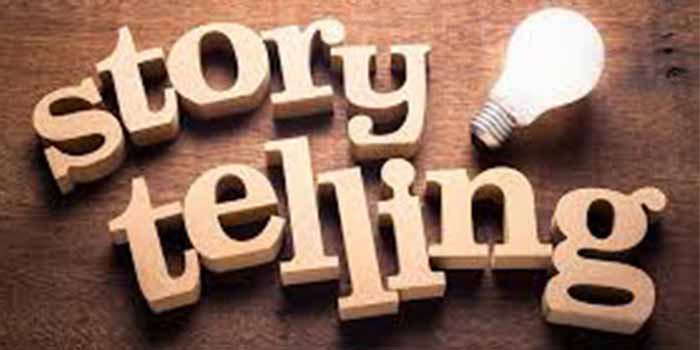
Image source
How To Use Storytelling In Copywriting To Skyrocket Sales
Are you using storytelling in your copywriting campaigns to boost sales? Isn't it fascinating how a well-crafted ad can stop you in your tracks?
Just imagine your rational self, mindlessly scrolling through your feed, when suddenly a message stops you and grabs your attention and won't let go.
And before you realize what's going on, you're hanging on every word, completely hooked.
Now, that's not just good copywriting, that's the magic of storytelling at its best.
But you may be wondering: what is copywriting?
Sure, copywriting is about persuasion. But the most persuasive tool isn’t a list of features; it’s a well-crafted story.
Studies have shown that infusing storytelling with your copy can help you to:
- Boost your conversion rates by up to 30%, according to Search Engine Watch.
- Make people 55% more likely to buy from you in the future, according to a study by Headstream.
- Increase the value of your product or service by a whopping 2,706%, according to the Significant Objects experiment.
So, what makes storytelling so powerful?
Let's dive in.
Why Story Telling In Copywriting Is A Powerful Tool
Your brain is a story-loving machine, always hungry for its next fix. A well-crafted story, delivered to the right audience at the optimal moment, can be a more potent sales tool than any other copywriting technique.
Why?
Because stories create an emotional response that triggers a deeper connection and understanding.
When you tell a story in your copy, you're not just selling a product or service; you're selling an experience, a solution to a problem, or a vision of a better future.
This emotional resonance is what makes your message memorable and persuasive.
The Science Of Storytelling
Stories can make your brain work in a way that other forms of communication simply can’t. More formal: In his TED Talk, David JP Phillips explains how stories can trigger the release of certain chemicals and hormones in your brain, such as...
In his TED Talk, David JP Phillip explains how stories can trigger the release of certain chemicals and hormones in your brain, such as:
- Dopamine: To stimulate dopamine production, a story must begin with an intriguing hook or unexpected twist. To do this, start your story with a mind-blowing question, a shocking statement, or a cliffhanger that'll leave your readers wanting more.
- Oxytocin: Want to make your audience feel connected to you? Oxytocin is the magic ingredient! When you share stories that tug at the heartstrings and make people feel something, you're releasing this empathy hormone. The more vulnerable and honest you are, the more your audience will trust you. And when they trust you, they're more likely to be generous and support your ideas.
- Endorphins flow when there's an emotional payoff, leaving you feeling satisfied. Share a heartwarming story that'll make your audience smile. Happy memories release endorphins, and your audience will associate those positive feelings with your copy.
Blend interest, excitement, comfort, arousal, and bonding in your stories, and you’ll have a recipe for captivating your audience.
By triggering these emotions, you’ll create a powerful connection that will leave your listeners eager to take action.
This isn't just fancy neuroscience – it's your secret weapon in copywriting.
The Building Blocks Of Story-Driven Copy

Image source
Let’s unlock the secret to powerful storytelling in copywriting. You don’t need to be a literary genius to write copy that sells.
All you need are the right ingredients. Here are the ingredients:
The Hook That Grabs Attention
Imagine you're at a loud party, trying to tell a friend something important. How do you get their attention? You don't just shout over the noise. You start with something that makes them stop, turn, and lean in.
The best story-driven copy works like a magician’s trick. It would help if you grabbed your reader's attention right away. Here are a few proven ways to do it:
- Shock them: Make a bold statement that challenges what they think they know.
- Relate to them: Share a moment of frustration or failure that they’ve experienced.
- Intrigue them: Ask a question that makes them curious.
- Promise them: Offer a solution to their deepest desires.
Example: "I used to think meditation was just for hippies and weirdos. But after losing $50,000 in a bad investment, a simple 5-minute breathing exercise saved my business."
The Character They Can't Forget
Every great story needs a hero your audience can root for. In copywriting, that means putting your customer in the spotlight:
- Make them the hero: Show how your product or service can help them achieve their goals.
- Create a relatable character: Share a story of someone just like them who overcame a challenge.
- Be vulnerable: Share your journey and struggles.
The secret to creating memorable characters? Make them real. Show their struggles, their doubts, and their weaknesses.
That’s how you connect with your audience on an emotional level.
The Conflict That Matters
A great story needs a good conflict. In copywriting, that means understanding the real problems your audience faces. Don’t just skim the surface. Dig deep.
The surface problem might be ‘I want to lose weight,’ but the real issue is often deeper. It’s about feeling judged and insecure.
On the surface, someone might say they need accounting software. But the real fear is making a mistake that could ruin their business. When you understand these deeper emotions, your story hits home.
Turning Features Into Stories
Many copywriters get stuck here. They have a great product with amazing features, but they can’t make it exciting. The trick? Turn each feature into a little story.
Instead of: "Our project management software includes real-time collaboration features."
Try: Imagine this: It’s 2 AM, and Sarah has a breakthrough. She immediately updates the project, and her team in different time zones picks up the work. There are no delays, no confusion, just seamless progress.
How Telling Stories Can Improve Your Copywriting

Image source
Storytelling is the secret weapon of top copywriters. When you master the art of storytelling, you can transform boring copy into compelling content that sells.
Here's how you can use storytelling to improve your copywriting and multiply your income:
- Grab Attention: In today’s world, attention spans are shorter than ever. But a good story can capture your audience and keep them hooked. A compelling story will keep your readers engaged from start to finish.
- Build Trust: Stories build authenticity in copywriting. When you share your real experiences or tell your brand’s story, you connect with your audience on a deeper level. People trust brands they know and like. And when they trust you, they’re more likely to buy from you.
- Draw Out Emotions: Emotions drive action. Tell stories that make your audience feel joy, empathy, or inspiration and you can create a deeper connection. When people feel emotionally connected to your brand, they become loyal customers.
- Help Your Audience Remember: People remember stories more than boring facts. When you tell a story, your message sticks. And that means more word-of-mouth buzz and repeat customers.
But what kinds of stories should you tell and how do you tell them?
Here you go...
The Most Persuasive Story Types To Use In Your Copywriting
These storytelling formats are not only fun to write but also incredibly persuasive. Test drive them today and watch your copy soar!
#1. Inspirational Stories
We all crave inspiration. Look no further than the booming self-help industry.
Why?
Because inspiration fuels us. It helps us push through tough times and achieve our goals. We’re drawn to stories of people who overcome challenges, just like us.
When your writing inspires people, you become more than just an expert. You become an authentic leader.
Want to tell stories that inspire your audience to take action?
Here’s the secret:
- Relate to their struggles: Share stories of people just like them who’ve faced similar challenges.
- Offer a solution: Show how your product or service can help them overcome those challenges.
Need inspiration? Look around you! Real-life stories, historical figures, movies, and even news headlines can provide powerful story ideas.
For example: A weight loss company could tell the story of someone who struggled with their weight, tried different diets, and finally found success with their product. This relatable story can inspire others to make a change.
#2. The Power Of Cautionary Tales
People are naturally curious, and that's why cautionary tales work so well. According to copywriting legend Gary Halbert, curiosity is the golden key to unlocking sales.
How it Grabs Attention:
Tell a relatable story about someone who made a mistake you can help your audience avoid.
We all hate feeling embarrassed or facing negative consequences, so this piques their interest. They'll want to know the mistakes to steer clear of.
Finding Inspiration:
- Real Life: Look for stories from people in your target market. What mistakes have they made? What were the consequences?
- Online: Dive into forums and social media groups relevant to your market. You'll find plenty of cautionary tales waiting to be discovered.
- News: Is there relevant news related to your niche? Stories about people getting hurt can be a powerful way to showcase how your product or service helps prevent similar situations.
Crafting Your Tale:
- Dramatize the Consequences: Don't sugarcoat the negative outcomes of making a mistake. Make it clear what's at stake.
- Highlight the Easy Solution: Show how easy it is to avoid these problems with your product or service.
Example: A self-defense copywriter might highlight stories of people getting attacked and explain how their product could have helped them avoid the situation.
Remember: Keep it relevant to your niche and audience.
By following these tips, you can harness the power of cautionary tales to create copy that grabs attention and drives sales.
Let's look at a classic example of 'mistakes to avoid' by Maxwell Sackheim...
#3. Hook Your Audience With History

Image source
Want to tell captivating stories that sell? Look to history! Find a famous historical figure and weave their story into your sales pitch. It's a simple, yet powerful technique.
The beauty of using historical figures is that the story already exists. You just need to unearth it and make it relevant to your audience.
The key is to find a fascinating story about a well-known historical figure. This will instantly capture your reader's attention and make your message memorable.
Make it Matter Today:
Don't just tell the story – bridge the gap. Explain how the historical figure's struggles or triumphs relate to the challenges your audience faces now.
Example:
Gary Halbert's famous colon cleanse sales letter uses Benjamin Franklin's daily routine. By highlighting Franklin's emphasis on health, Halbert connects with the reader's desire for well-being.
Remember:
- Keep it interesting! Find a unique twist on a familiar story.
- Focus on the connection! Make sure the historical figure's story relates to your product and its benefits.
Here’s an example:
Colon Cleanse Salesletter by Gary Halbert
#4. The Star, Story, Solution Formula
This classic advertising technique isn't technically a story, but it's incredibly effective. It's a simple formula that can help you sell more:
- The Star: Identify a well-known person or character who embodies a certain quality or aspiration. It could also be you or your client.
- The Story: Share a story about this star that highlights a common problem, challenge, woe, etc…. that is shared by your target audience.
- The Solution: Explain how your product or service can help your audience achieve similar results.
We love a good underdog story. It’s a classic formula that never fails to capture our hearts.
Here's why it works:
- Relatable Struggles: Your audience sees themselves in the main character. They've faced similar challenges and can empathize with their journey.
- Emotional Connection: As they read the story, they relive those feelings and emotions. It creates a powerful connection.
- Hopeful Resolution: You offer a solution – your product or service. It shows them a way to overcome their own struggles.
Example: The Amazing Money-Making Secret Of A Desperate Nerd From Ohio
By following this formula, you can create compelling copy that resonates with your audience and drives sales.
#5. The Hell to Heaven Story: A Powerful Transformation

Image source
Imagine a story of someone who's been through the wringer, faced countless challenges, and emerged victorious.
This is the essence of the "hell to heaven" story, one of the most persuasive storytelling techniques.
Why it Works:
- Relatability: Your audience sees themselves in the protagonist's struggles.
- Emotional Impact: The journey from despair to triumph evokes strong emotions.
- Hopeful Ending: The happy ending inspires your audience and shows them a path forward.
How to Tell It:
- Identify the Struggles: What challenges does your target audience face?
- Create the Hero: Develop a character who embodies those struggles.
- The Fall: Describe the challenges and setbacks your character faces.
- The Rise: Show how your product or service helps them overcome these challenges.
- The Triumph: Celebrate their success and inspire your audience.
By crafting compelling "hell to heaven" stories, you can connect with your audience on a deeper level and drive sales.
Additional Storytelling Tips:
1. Get to the Point:
- Cut to the chase. Dive straight into the most exciting part of the story.
2. Tap into Emotions:
- Understand your audience's pain points and frustrations.
- Use vivid language to evoke strong emotions.
3. Keep it Concise:
- Less is more. Trim unnecessary details and focus on the key elements that drive the story.
4. Amplify the Drama:
- The more dramatic the story, the more engaging it becomes.
- Build tension and create a sense of urgency.
Conclusion: The Power of Storytelling
The more stories you tell, the more money you'll make. It's that simple.
Use these five storytelling formats as your blueprint for creating a persuasive copy:
- The Hook Story: Grab attention with a surprising statement or question.
- The Underdog Story: Inspire your audience with a tale of triumph over adversity.
- The Cautionary Tale: Warn your audience about the consequences of inaction.
- The Historical Tale: Leverage the power of history to connect with your audience.
- The Star, Story, Solution: Highlight a famous figure and show how your product or service can help people achieve similar results.
Practice these techniques, and you'll become a master storyteller who can captivate your audience and drive sales. Would like for us to tell your story?
 WhatsApp us at: +234 080 331 75396
WhatsApp us at: +234 080 331 75396

















